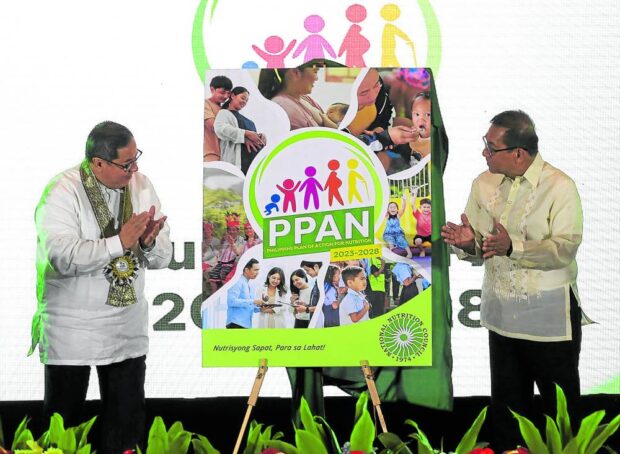5-year plan to fight malnutrition formed

WHOLE-OF SOCIETY INTERVENTION | National Nutrition Council (NNC) Board Chair and Health Secretary Teodoro Herbosa with Science and Technology Secretary and NNC member Renato Solidum Jr. unveil the “Philippine Plan of Action for Nutrition 2023 – 2028” during its national launching at Manila Hotel in Manila on Monday, Sept. 4, 2023. (Photo by RICHARD A. REYES / Philippine Daily Inquirer)
MANILA, Philippines — A five-year roadmap to combat malnutrition calls for whole-of-society interventions to increase Filipinos’ access to nutritious food and promote better feeding practices, especially for babies and young children, officials said on Monday.
Health Secretary Teodoro Herbosa and Science Secretary Renato Solidum Jr. led the official launch of the new Philippine Plan of Action for Nutrition (PPAN) from 2023 to 2028 at the Manila Hotel.
Herbosa said the PPAN would serve as the blueprint to guide the government, nongovernmental organizations, academe and the private sector in a coordinated effort to reduce all forms of malnutrition.
“Nutrition is most critical in the first 1,000 days of life— from day one of pregnancy and up to the second year of birth of a child. If left neglected, poor nutrition results in child stunting, which is irreversible, and more importantly, poor brain development,” said Herbosa, who chairs the National Nutrition Council (NNC) governing board.
“If the child survives, it is likely that he will have low performance in school, become less productive as an adult. This ugly cycle of malnutrition must stop at all costs,” he said.
Article continues after this advertisement11th national plan
The PPAN is the country’s 11th national plan to eradicate malnutrition since 1974.
Article continues after this advertisementSince then, according to the NNC, micronutrient deficiencies, or the lack of essential vitamins and minerals required by the body, among Filipinos have dropped to a level below public health significance while the prevalence of underweight children has also declined.
The new PPAN seeks to address all forms of malnutrition “with a particular focus on stunting and wasting, overweight and obesity, poor infant and young child feeding practices, and micronutrient deficiencies,” according to the Council, which led its formulation.
The Philippines remains to have “high levels of child stunting with 26.4 percent or 1 in every 4 children under five years of age are short for their age,” said the Council.
“Compared to other countries in the Asean (Association of Southeast Asian Nations), the decline in child stunting prevalence in the Philippines has been steady but progress has been slow,” it added.
Children with stunted development are four times more likely to die, have reduced intelligence quotient by as much as 11 points, and have 22 percent reduced earning potential.
On a macroeconomic level, the Philippines loses about 1.5 to 3 percent of its gross domestic product annually because of child stunting.
The NNC also pointed out a steady increase in overweight or obese Filipinos.
Interventions
Azucena Dayanghirang, executive director of NNC, identified three major interventions under the PPAN: increasing availability and access to nutritious food; social and behavioral change for better feeding practices, and improving access to quality nutrition services.
Interventions to increase access to nutritious food include the establishment of food gardens in the school, community and workplace; setting up Kadiwa stores; dietary supplementation program; food stamps or cash transfers, and regulation of unhealthy food.
Interventions to promote social behavior change include offering maternal health service packages; infant and young children feeding programs, and support for breastfeeding mothers.
Meanwhile, interventions to improve access to quality services include integrated maternal and child health nutrition services; nutrition services in schools; growth monitoring and promotion; and adolescent health and development programs.
The PPAN has identified 34 provinces as priority areas: Leyte, Sulu, Negros Occidental, Negros Oriental, Samar, Lanao del Norte, Masbate, Palawan, Basilan, Cebu, Camarines Sur, Quezon; Zamboanga del Norte, Zamboanga del Sur, Maguindanao, Bukidnon, Iloilo, Cavite, Bulacan, Cotabato, Oriental Mindoro, Pangasinan, Rizal, Davao del Sur, Nueva Ecija, Isabela, Pampanga, Sorsogon, Eastern Samar, Northern Samar, Surigao del Sur, Zamboanga Sibugay, Antique and Tawi-Tawi.